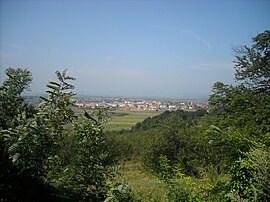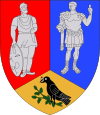Hațeg
You can help expand this article with text translated from the corresponding article in Romanian. (April 2014) Click [show] for important translation instructions.
|
Hațeg | |
|---|---|
 Hațeg panorama | |
 Location in Hunedoara County | |
| Coordinates: 45°36′27″N 22°57′0″E / 45.60750°N 22.95000°E | |
| Country | Romania |
| County | Hunedoara |
| Government | |
| • Mayor | Marcel Goia[1] (PNL) |
| Area | 64.33 km2 (24.84 sq mi) |
| Population (2021-12-01)[2] | 8,793 |
| • Density | 140/km2 (350/sq mi) |
| Time zone | EET/EEST (UTC+2/+3) |
| Vehicle reg. | HD |
| Website | primariehateg |

Hațeg (Romanian pronunciation: [ˈhat͡seg]; German: Wallenthal; Hungarian: Hátszeg) is a town in Hunedoara County, Romania with a population of 9,340. Three villages are administered by the town: Nălațvad (Nalácvád), Silvașu de Jos (Alsószilvás), and Silvașu de Sus (Felsőszilvás). It is situated in the historical region of Transylvania.
History
In 1765, while part of the Habsburg controlled Principality of Transylvania, the settlement was completely militarised and integrated into the Second Border Company of the First Border Regiment from Orlat, until 1851, when that unit was disbanded.
Geology
Țara Hațegului (the Hațeg Country) is the region around the town of Hațeg. The fossils found in the Hațeg area span over 300 million years of Earth's geologic history, showing tropical coral reefs and volcanic island in the Tethys Sea, dinosaurs, primitive mammals, birds, and flying reptiles (such as Hatzegopteryx, which was named for the region).
Hațeg Island was an island during the Cretaceous Period where a dwarf species of sauropod dinosaur, Magyarosaurus dacus, lived until their extinction at the end of the Cretaceous. Baron Franz Nopcsa published articles about these Mesozoic-era archosaurs on Hațeg Island. His studies led to his theory of insular dwarfism, the notion that "limited resources" on small islands can lead to a down-sizing of the indigenous vertebrate animals.[3]
Demographics
| Year | Pop. | ±% |
|---|---|---|
| 1912 | 3,124 | — |
| 1930 | 3,383 | +8.3% |
| 1948 | 3,210 | −5.1% |
| 1956 | 3,853 | +20.0% |
| 1966 | 5,631 | +46.1% |
| 1977 | 8,423 | +49.6% |
| 1992 | 11,616 | +37.9% |
| 2002 | 12,507 | +7.7% |
| 2011 | 9,685 | −22.6% |
| Source: Census data | ||
Natives
Gallery
-
European bison in Hațeg nature reserve
-
Struthiosaurus transylvanicus, a herbivorous reptile dating from Late Cretaceous, first discovered in the Haţeg area
-
Saint Nicholas Orthodox Church
-
Historic bank building, today Hotel Ferdinand
-
Reformed Church
-
Synagogue
-
Nalatzi-Fay Manor, Nălațvad
-
Trajan's Road near Hațeg (1900-1920)
-
Interior of the Greek-Catholic Church (1900-1920)
See also
References
- ^ "Results of the 2016 local elections". Central Electoral Bureau. Retrieved 3 April 2020.
- ^ "Populaţia rezidentă după grupa de vârstă, pe județe și municipii, orașe, comune, la 1 decembrie 2021" (XLS). National Institute of Statistics.
- ^ Csikia, Z.; M. J. Bentonb (2010). "An island of dwarfs — Reconstructing the Late Cretaceous Hațeg palaeoecosystem". Palaeogeography, Palaeoclimatology, Palaeoecology. 293 (3–4): 265–270. doi:10.1016/j.palaeo.2010.05.032.
External links
 Hațeg travel guide from Wikivoyage
Hațeg travel guide from Wikivoyage- Hațeg City Hall Official Site (in Romanian)












